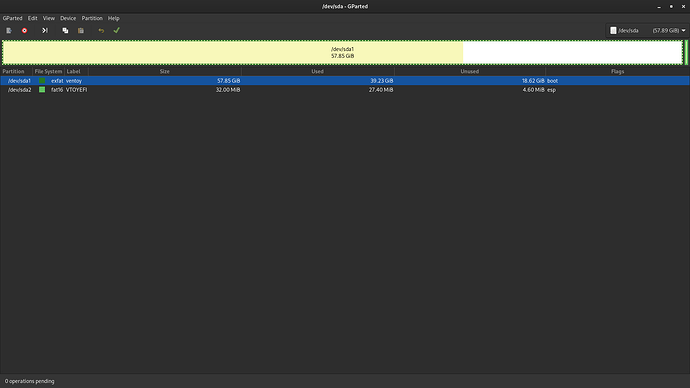Hi,
I wanted to store in the HD some .ISO to boot them in case of severe issue on main system.
I installed the module grml-rescueboot and began to put in the /boot/grml directory a few potentially useful ISO (System rescue, Clonezilla and the last EOS).
After the grub update all the entry are present in menu at boot, but only System rescue ISO starts up, the other ask me to press a key and they return to main grub menu.
Is there something else that i have to do?
If your HD crashes and fails that will do you little good with the ISO on the HD, use a USB stick for the ISO and carry on with life. ![]()
If the HD crashes (hw) you can’t use ISO on HD, but if the system fails (sw) by a wrong command or a update the ISO is very useful to have them available on HD.
It avoids frantically searching for the USB put who knows where. ![]()
Whenever I need to chroot into a failed system, I download the latest ISO and use that after making a bootable USB. You don’t need to use the same ISO that you use to install the OS.
Thank you for the information.I am glad to know that you have a lot of time on your hands, but I would like to solve my problems as I decide. Our exchange of ideas, which is not useful to me, can end here.
Just keep a bootable USB drive somewhere where you won’t misplace it. Your computer case is a good option, or stick it behind a monitor with some removable adhesive putty (the monitor stand is probably the best place). Or tie it with a zip tie to one of the cables of your PC. If you use a laptop, your laptop bag is the most obvious place to store it.
USB drives are dirt cheap, use this one only for this purpose and nothing else.
Why do you tell me how I should behave instead of giving me a hand on the question ?
If you don’t know, no point in answering, thank you
Just giving you (and anyone else reading this thread) some good advice, nothing else. You’re perfectly free to ignore it, I won’t be sad if you do.
I guess if I were going to try and do this, I would probably make a ventoy partition on the HDD to boot from and then put the things in the ventoy partition to load from?
Theoretically of course, I’ve never tried.
As Sammie and Kresimir already assisted mentioned, this is infinitely easier to do with just a USB, which is how I also go about this process.
This is a good advice, I hadn’t thought of that. ![]() Thanks
Thanks
It Is just to figure out how to put the corresponding grub section. I will think about it…
It seemed too easy to do with Ventoy. But with non-destructive installation the MBR and the first 1MB area before the 1st partition will be overwritten. So it can’t be used it on a disk which contains MBR bootloader. I have only one HD where there is grub with partitions EOS/Windows, I don’t know if it will destroy everything, I prefer not to risk it
Ventoy will format and install to the whole disk and not to a particular partition.
I have installed Ventoy on a 64 GB USB flashdrive with a number of ISOs (Windows and several Linux distros) including some recovery tools. It has been working just fine for me. Nothing to report.
Here below you can see how it formats and partitions the drive:
Model: Sony Storage Media (scsi)
Disk /dev/sda: 62.2GB
Sector size (logical/physical): 512B/512B
Partition Table: msdos
Disk Flags:
Number Start End Size Type File system Flags
1 1049kB 62.1GB 62.1GB primary boot
2 62.1GB 62.2GB 33.6MB primary fat16 esp
sudo ventoy -l /dev/sda
**********************************************
Ventoy: 1.0.96 x86_64
longpanda admin@ventoy.net
https://www.ventoy.net
**********************************************
Ventoy Version in Disk: 1.0.91
Disk Partition Style : MBR
Secure Boot Support : YES
Yes, I agree. Ventoy is not the solution for this purpose. I would need a second disk
It’s not advice. My advice would be to do as others says and to use a USB.
It’s a hypothetical possibility to solve your very odd scenario. I would not advise doing this, it just may work .
Hi, I have not used grml, so I can not comment on that, but I have managed to boot ISOs from disks and network with “pure” grub before.
Make sure that you have secureboot disabled (I guess it already is), and that that there is loopback option in the grub menu entry, and that iso name does not contain any spaces.
Also, if the ISO image is in the UDF format, you need to do insmod udf in grub before setting other options.
Here is one article with detailed explanation that could help you https://www.linuxbabe.com/desktop-linux/boot-from-iso-files-using-grub2-boot-loader
Thank you. Me too I’ve tried tho use “pure” grub putting ISOs in a disk partition and modifying the the grub configuration file 40_custom, but with any positive result.
Now I will read the article and retry.
hmm reminds me on mass producing EndeavourOS pendrives…

Fortunately, we are not talking about floppies and CDs ![]()
It’s working at last! With the advice from the article of the link I was able to boot the Clonezilla ISO I downloaded to a partition on the HD. I omitted the “insmod ext2” parameter that makes it work, Even what is stated about it on the Clonezilla site had not worked. Thank you, no more USB sticks.
Wow! All this wrangling and work so you don’t have to remember where that dang usb stick was last placed. Bravo! ![]()
